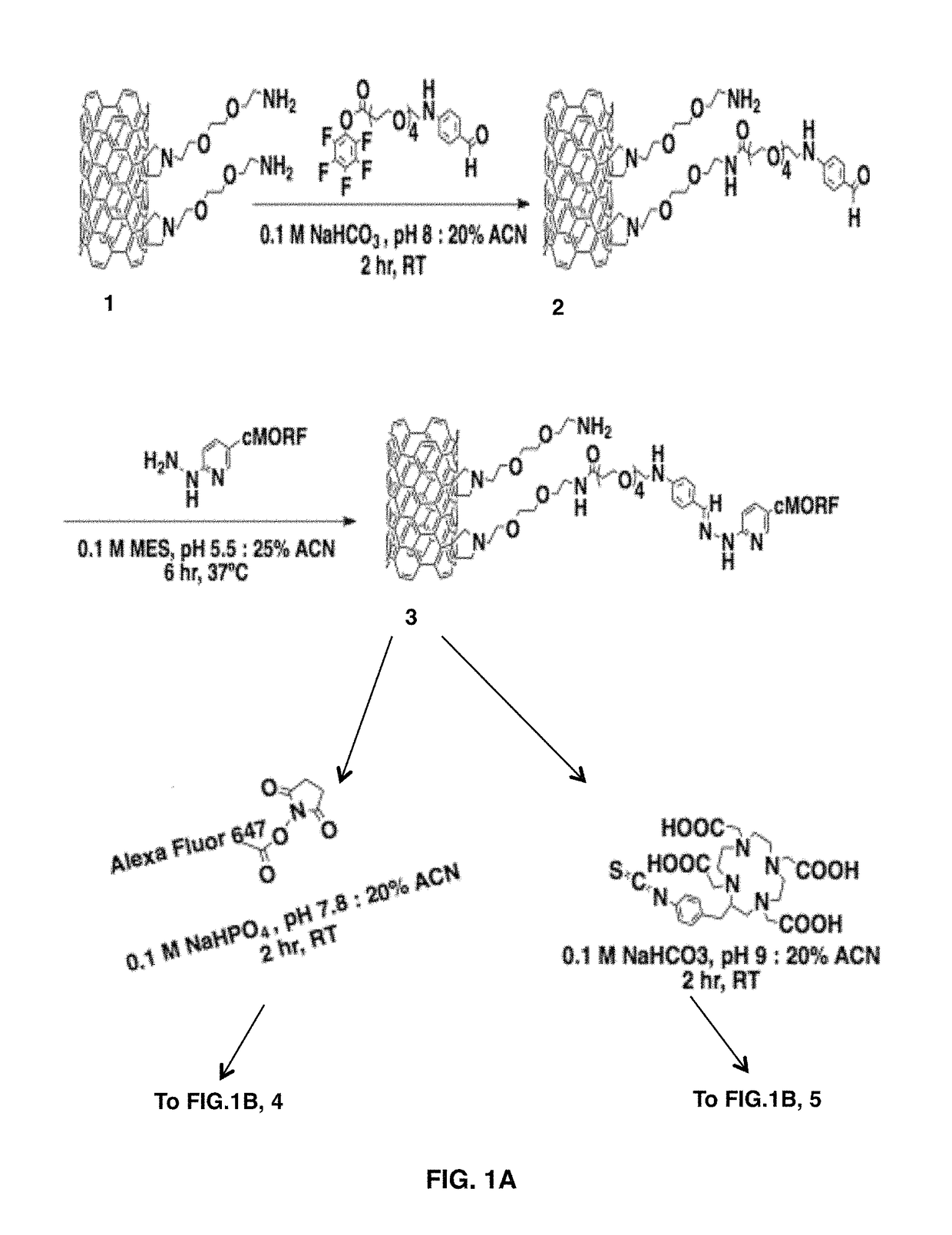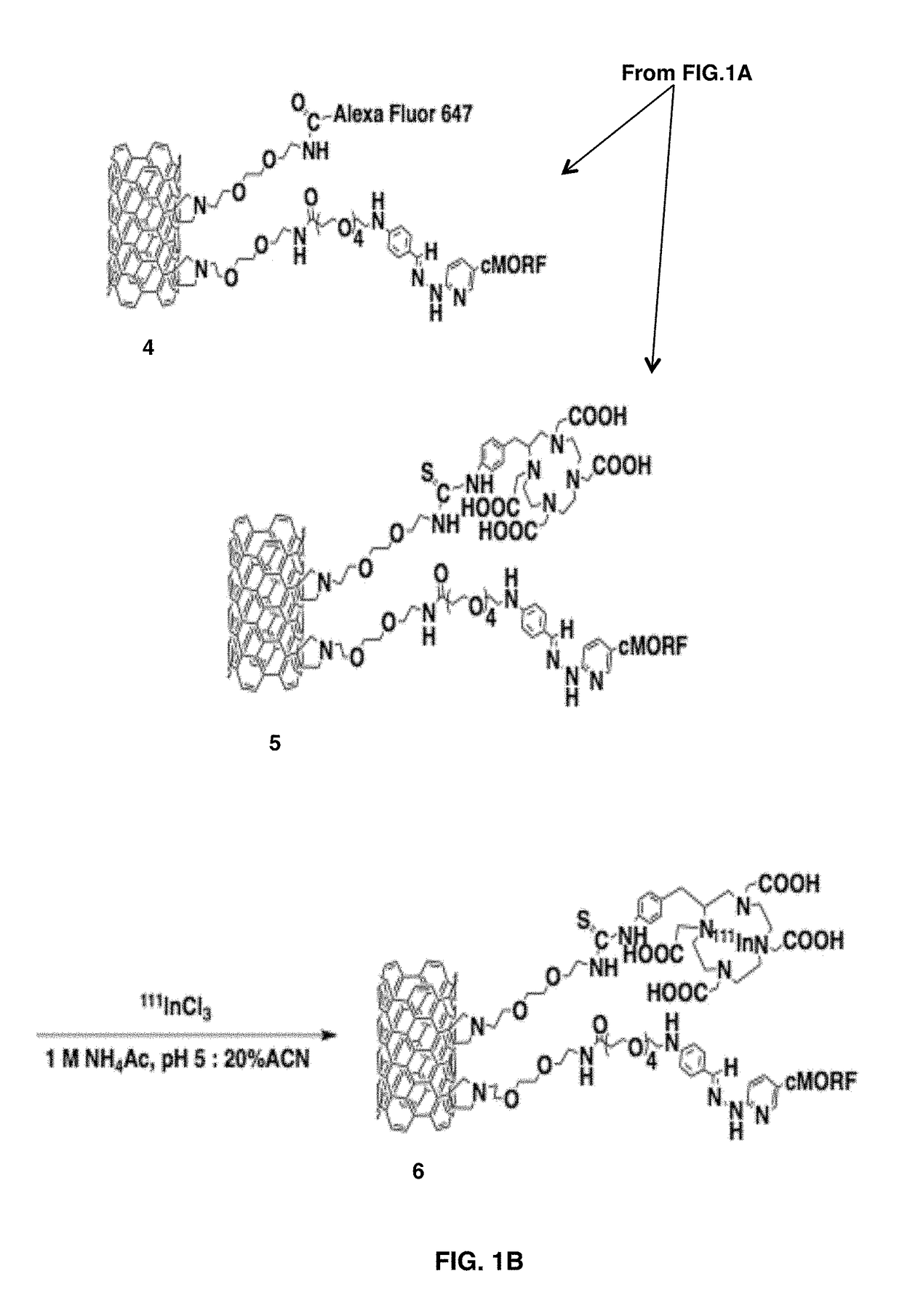Targeted self-assembly of functionalized carbon nanotubes on tumors
a carbon nanotube and tumor technology, applied in the field of tumor targeting, can solve the problems of short circulation time of the agent, increase the toxicity, reduce the time, etc., and achieve the effects of reducing the time, reducing the time, and reducing the tim
- Summary
- Abstract
- Description
- Claims
- Application Information
AI Technical Summary
Benefits of technology
Problems solved by technology
Method used
Image
Examples
example 1
Methods and Materials
Modification of SWNT
[0058]High purity (>90%) single walled carbon nanotubes were obtained from NanoLab Inc (Waltham, Mass.). These arc-discharge produced single-walled carbon nanotubes were reacted according to described protocols (33) to produce SWNT-NH2. The SWNT-NH2 product was purified on a C18 Seppak (Waters) by application and wash in 20% acetonitrile: 0.1 M triethyl amine acetate. The purified product was eluted with 50% acetonitrile:water. This solution was then lyophilized to give the dark brown SWNT-NH2 solid, or diluted directly into a bicarbonate buffer (0.1 M Na HCO3, pH 9). To the SWNT-NH2 was added 0.6 mmol / g of PEG4 / PFB (Solulink) long chain crosslinker. This reaction was allowed to proceed for 2 hours at room temperature. The reaction mixture was then purified on a disposable benchtop 10-DG size exclusion column (Biorad), with elution of the aldehyde and amine bearing SWNT-4FB-NH2 (2) product into a 0.1 M MES, 0.15 M NaCl, pH 5.5 buffer.
Conjugat...
example 2
Oligonucleotide Modification and Radiolabeling of SWNT
[0078]The amine functionalized single-walled carbon nanotubes (FIG. 1A, 1) used herein were prepared from high purity arc-produced single-walled carbon nanotubes or HiPCO SWNT via covalent cycloaddition of azomethine ylides as described (27-28). This reaction attaches hydrophilic chains to the single-walled carbon nanotubes sidewalls that could be terminated with primary amines to serve as the attachment site for bifunctional radiometal chelates, fluorophores, and the morpholino oligonucleotide complementary to a modified antibody (cMORF).
[0079]Constructs averaged 350 nm in length by DLS (Zetasizer Nano Zs system equipped with a narrow bandwidth filter (Malvern Instruments)) and TEM (EM-201 (Philips)) with diameter of approximately 1.2 nm giving 12 carbon atoms per 2.5 angstroms. They were characterized by Raman spectroscopy (InVia micro Raman system (Renishaw)).
[0080]In order to append the morpholinos to both the targeting antib...
example 3
SWNT-cMORF Hybridizes with Multiple Different mAb-MORF In Vitro and in the Presence of Serum at 37°
[0088]Hybridization of the antibody-MORF onto the SWNT-cMORF conjugate could be monitored through HPLC (FIGS. 2A-2D). The mAb-MORF conjugates alone had an elution time of approximately 18 minutes, which was consistent with a molecular weight of ˜150,000 Da based on protein standards. When the mAb-MORF, anti-CD20-MORF and anti-A33-MORF, was incubated with the complementary SWNT-cMORF construct, the nanotube elution shifted to a high-molecular-weight band and eluted at the void volume at 12 min. (FIG. 2B). The column's molecular weight cutoff is 600 kDa, suggesting that multiple antibodies were hybridizing to the single-walled carbon nanotubes to form large, but still soluble, multimeric constructs (FIG. 2A).
[0089]In order to specifically monitor the elution of the SWNT-cMORF through an appended label, a similar experiment was performed with radiolabeled SWNT-cMORF-111In(DOTA) (FIG. 2B, ...
PUM
| Property | Measurement | Unit |
|---|---|---|
| circulation time | aaaaa | aaaaa |
| pH | aaaaa | aaaaa |
| pH | aaaaa | aaaaa |
Abstract
Description
Claims
Application Information
 Login to View More
Login to View More - R&D
- Intellectual Property
- Life Sciences
- Materials
- Tech Scout
- Unparalleled Data Quality
- Higher Quality Content
- 60% Fewer Hallucinations
Browse by: Latest US Patents, China's latest patents, Technical Efficacy Thesaurus, Application Domain, Technology Topic, Popular Technical Reports.
© 2025 PatSnap. All rights reserved.Legal|Privacy policy|Modern Slavery Act Transparency Statement|Sitemap|About US| Contact US: help@patsnap.com



